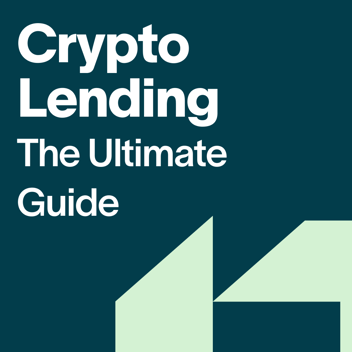Crypto Peer-to-Peer (P2P) Lending: Beginner's Guide

Discover the world of crypto P2P lending with our beginner's guide. Understand the advantages, risks and alternatives, so you can make an informed decision.
Introduction
This beginner's guide to crypto peer-to-peer (P2P) lending will take you through the advantages, risks and alternatives. You’ll be equipped with the knowledge you need to make informed decisions.
What is Peer-to-Peer (P2P) Lending?
P2P lending is a transaction between two parties: a lender and a borrower. They connect directly, cutting out the need for traditional, intermediary financial institutions, such as banks.
Lenders, or investors, earn a profit on the loan, in the form of interest. The borrower uses the funds for whatever they like.
These loans might be personal loans, business loans, loans for cars, mortgages, student loan refinancing, medical loans and more.
As there is no middleman taking a cut, interest rates are often better for both parties.
This type of lending is accessible to people who don’t meet traditional lenders’ requirements, due to their location, credit history, or lack of assets like a house.
Related Content: The Ultimate Guide to Crypto Lending
How does P2P Lending Work?
Today, when someone needs a loan, they usually visit an online P2P platform and submit their loan request. Investors, or lenders, review these requests and decide which ones to fund, based on the risk associated with the borrower. One lender or several can take on the loan.
Once a loan is fully funded, the borrower receives the money and starts making monthly repayments. P2P platforms handle the transactions and ensure a smooth experience for both parties.
Lenders can receive interest payments monthly, quarterly, or annually. At the end of the loan term, the lender can expect to get back their original investment, plus interest.
How does Crypto P2P Lending Work?
These loans work much like the ones described above. However, they are denominated in cryptocurrency and executed on a blockchain network.
For borrowers:
- Borrowers create loan listings, stating how much cryptocurrency they need and what they'll use it for.
- Lenders review these listings and decide which loans to fund based on interest rates and risk levels.
- Once the loan is funded, borrowers receive the cryptocurrency in their digital wallet.
For lenders:
- Lenders browse through different loan listings and choose which ones to invest in.
- They send their chosen amount of cryptocurrency to the borrower's wallet.
To make everything secure and transparent, ‘smart contracts’ are used. These are digital agreements written in code. They automatically handle the loan disbursement and repayments, ensuring that everyone sticks to the agreed terms.
Types of P2P Crypto Lending Platforms
There are two types of P2P crypto lending platforms: Decentralized Lending Platforms and Centralized Lending Platforms.
Decentralized Lending Platforms
Decentralized lending platforms, often referred to as DeFi platforms, are run solely by smart contracts.
The lending process revolves around lending pools. Users add their assets, and smart contracts handle distribution to borrowers. As a result, crypto holders can become lenders like banks, earning interest on their assets by lending them to others.
DeFi lending is faster and more efficient than traditional banking. Lengthy customer checks are eliminated. Instead, borrowers need to meet collateral requirements to secure a loan. Smart contracts streamline the reviewing process, benefiting both borrowers and lenders.
Related Content: Crypto Loans without Collateral
Centralized Lending Platform
Centralized lending platforms, often referred to as CeFi platforms, are operated by people or institutions, rather than smart contracts alone.
These platforms have more in common with online banking and loan services, making them more user-friendly, especially for beginners.
While no platform is immune to risks, CeFi exchanges typically provide extra security measures that reduce the chances of being hacked. They might also offer additional services, customer support, and insurance.
Related Content: CeFi vs DeFi - Key Differences Explained
Risks Involved with P2P Crypto Lending
P2P crypto lending is one of the riskier ways to lend your crypto. Here are some key risks to be aware of:
Volatility and Price Fluctuations
The value of cryptocurrencies can rapidly and unpredictably fluctuate. This can affect the value of collateral provided by borrowers to secure their loans. If the collateral's value decreases significantly, it may no longer be sufficient to cover the loan, potentially leading to loan defaults.
For lenders, this volatility can cause the value of their investment to drop. As a result, lenders may face losses when they convert their earned interest and principal back to their preferred currency.
Lack of Regulations and Legal Framework
In traditional financial systems, regulations provide a level of protection to borrowers and lenders. Crypto regulations are evolving and vary from country to country. P2P lending is one of the most unregulated forms of crypto lending.
P2P lending platforms and participants may encounter uncertainties regarding compliance and legal responsibilities. The absence of legal frameworks may also make it difficult to address fraud or scams.
To address these concerns, some P2P lending platforms have set up their own internal policies and guidelines. However, these may not offer the same level of security and confidence as regulations enforced by government bodies or financial authorities.
Possibility of Loan Default, Fraud, and Financial Losses
When you lend your crypto to someone else, there's a chance they may not be able to repay you. This is known as defaulting. It can happen as a result of financial hardships or unexpected events. The low barriers to P2P lending mean that borrowers who pose more of a credit risk may slip under the radar. When borrowers default, lenders might not get back the full amount they lent.
On unregulated P2P platforms, there’s a higher chance borrowers engage in fraudulent activities or misrepresent their creditworthiness. The chances of losses for lenders are higher.
Related content: Proof of Reserves in Crypto, Explained
Risk of Platform Insolvency
P2P lending platforms may face financial instability or unexpected shutdowns. These events risk the safety of users’ funds. Last year, crypto lender Celsius announced it was stopping all client withdrawals from its platform, then filed for bankruptcy, leaving investors rushing to recover their assets.
Lack of Liquidity
There’s not much of a secondary market for P2P loans. If you do need to regain access to your loaned assets, you'll probably have to sell the loan on at a major discount. For this reason, these loans are best viewed as a buy-and-hold proposition.
Is Crypto P2P Lending Safe?
The risks associated with crypto-based peer-to-peer lending vary significantly and are influenced by a multitude of factors.
These factors include the platform you select, the type of crypto you lend, and the borrower you partner with.
Related Content: The Risks of Crypto Lending
Platform
Some platforms may have robust security measures and reputation, reducing the likelihood of fraud or loss of funds. Others may lack adequate safeguards, increasing the risk of potential scams or platform insolvency.
Cryptocurrency
The type of cryptocurrency you lend can influence risk due to its inherent volatility and market behaviour. More established and widely adopted cryptocurrencies may carry lower risks compared to newer or less-known cryptocurrencies, which can experience rapid and unpredictable price fluctuations.
Borrower
Evaluating the creditworthiness and collateral provided by the borrower makes P2P crypto lending safer. High-risk borrowers have a higher chance of default, leading to potential financial losses.
Related Content: How to Borrow Against Crypto
The Advantages of P2P Crypto Lending
P2P crypto lending offers several advantages that make it an appealing option for borrowers and lenders. By cutting out traditional financial intermediaries and using blockchain technology, P2P crypto lending offers a transparent, efficient, and accessible lending ecosystem.
Potential for Higher Returns
High yields are the leading draw of these loans. Lenders can earn 10% annual interest, or more, in passive income. On top of this, platform fees are low or zero.
Diversification of Investment Portfolio
Lending crypto can help diversify your investment holdings. You can elect to fund entire loans or buy parts of a loan, referred to as ‘notes’, in increments as small as a few dollars. This diversification lowers risk exposure.
Flexibility and Accessibility
P2P crypto offers a more straightforward and rapid loan application process than to traditional banks. Borrowers can access funds in minutes, with minimal bureaucracy and paperwork. Borrowers with limited access to banking services or lower credit scores may find P2P crypto lending more accommodating.
The Disadvantages of P2P Crypto Lending
While it has a number of advantages, P2P crypto lending also comes with its share of disadvantages. There are simpler and safer ways to borrow against your crypto, which we'll go into later on.
The key disadvantages of P2P crypto lending include:
Volatility
The cryptocurrency market's inherent volatility can add an extra layer of risk. The value of collateral and borrowed assets may fluctuate significantly, impacting the stability of the loans.
Double sided market
Finding borrowers and lenders that meet each other's needs requires time and effort, potentially slowing down the loan matching process.
For borrowers, finding a lender who offers the desired loan amount at a competitive interest rate can be challenging. It involves evaluating various loan listings, negotiating terms, and ensuring alignment with borrowing needs.
On the other hand, lenders struggle to find trustworthy borrowers with good creditworthiness and attractive collateral. Varying terms and conditions among different borrowers and lenders contribute to a fragmented marketplace, further complicating the search for perfect matches.
Potential for Losses
Peer-to-peer lending lacks a central authority, leading to increased risks like potential defaults or fraud due to the absence of strict oversight. Defaults and fraud by borrowers can lead to financial losses for lenders.
The Best Alternatives to Crypto P2P Lending
There are other ways to invest your crypto that also generate attractive returns. If P2P lending isn't the right fit for you, consider exploring these alternative options.
Crypto Savings Accounts
Accessible and versatile, crypto savings accounts are a low-risk way to earn passive income through lending your cryptocurrency. When you deposit your crypto assets into these accounts, the platform lends them to borrowers and you receive interest on your holdings. Interest rates are influenced by various factors like the lending platform's model, market conditions, and the type of cryptocurrency you deposit.
Crypto savings accounts are typically offered by centralized exchanges, lending platforms, or specialized crypto banking platforms. The top platforms offer account management tools, user-friendly interfaces, and seamless deposit and withdrawal options.
Ledn’s BTC and USDC savings accounts have a transparent fee structure. You can earn up to 9% APY interest.
Yield Farming
Yield farming projects require lenders to lock their cryptocurrency tokens for a specific period, offering rewards in return. These projects, managed with smart contracts, offer interest rates ranging from a few percentage points to triple-digits. The locked tokens can be lent to other users, who pay interest on their crypto loans, benefiting liquidity providers.
Alternatively, locked tokens provide liquidity for decentralized exchanges, supporting trading activities. Yield farmers earn passive income through transaction fees. On top of this, they often receive additional liquidity incentives, including governance tokens and newly minted tokens.
Conclusion
Crypto peer-to-peer (P2P) lending offers some advantages, but there are a number of inherent risks.
Finding your loan counterpart can take some time. The absence of regulatory safeguards leaves lenders and borrowers susceptible to scams and defaults. The unpredictable nature of cryptocurrencies can destabilize deposits or even entire platforms. We’d recommend exercising caution in this unregulated domain.
Interested in alternatives to P2P Crypto Lending? Check out Ledn, the leader in centralized crypto lending.
Sponsored by 21 Technologies Inc. and its affiliates (“Ledn”). All reviews and opinions expressed are based on my personal views.




